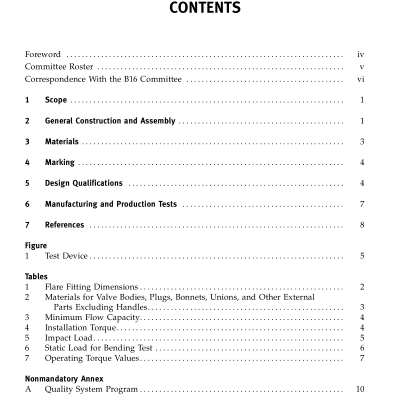ASME B16.44-2002 pdf free download.MANUALLYOPERATED METALLIC GAS VALVES FOR USEIN ABOVEGROUND PIPING SYSTEMS UP TO 5 PSI
3 MATERIALS
3.1 Materials for Valve Bodies, Plugs, Bonnets, Unions, and Other External Parts Excluding Handles Materials known to be acceptable for compliance with this Standard are listed in Table 2. Other metallic materi- als may be used when the product incorporating them meets the requirements of the Standard. 3.2 Lubricants and Sealants Lubricants and/or sealants shall be resistant to the action of fuel gases such as natural, manufactured and LP gases. The valve manufacturer is responsible for the selection of lubricants and sealants, and for the determi- nation of their suitability for service conditions enumer- ated in para. 1 of this Standard. 3.3 Seating and Stem Seal Materials
3.3.1 Elastomer Components — Air Aging. Elastomer parts that are exposed to fuel gas shall be made from materials that, following 70 hr air aging in accordance with ASTM D 573 at 212°F (100°C), meet the elongation, tensile and hardness property requirements of 3.3.1.1 and 3.3.1.2. 3.3.1.1 Tensile tests shall be conducted on six dumbbells in accordance with ASTM D 412. Three dumbbells shall be air aged 70 hr in accordance with ASTM D 573 at 212°F (100°C). The dumbbells shall have a thickness of 2.0 ± 0.2 mm (0.08 ± 0.008 in.). The average of the three individual tests for the aged dumbbells shall exceed 60% retention of ultimate elongation and 60% retention of tensile strength at break. The average of the three individual tests for the non-aged dumbbells shall be the basis for percent retention calculation.
3.3.1.2 Hardness tests shall be conducted using specimens in accordance with ASTM D 395, Type 2. Three specimens shall be air aged 70 hr in accordance with ASTM D 573 at 212°F (100°C). The average of the three individual tests for the aged specimens shall not show a hardness change of more than ± 10 Shore hard- ness points relative to the average hardness of the non- aged specimens. 3.3.2 Elastomer Components — Swell Test. Elastomer parts that are exposed to fuel gas shall be made from materials that, after 70 hr exposure in n-hexane at 73°F (23°C), in accordance with ASTM D 471, meet the vol- ume change, elongation, and tensile property require- ments of paras. 3.3.2.1 and 3.3.2.2.
3.3.2.1 Volume change tests shall be conducted using six specimens in accordance with ASTM D 471, Section 8. Three specimens shall be exposed for 70 hr at 73°F (23°C) in n-hexane in accordance with ASTM D 471. The average ofthe three individual n-hexane tests shall not show an increase in volume of more than 25% or a decrease in volume of more than 1%. The average of the three tests for the non-aged specimens shall be the basis for the percent retention change calculation.
3.3.2.2 Tensile tests shall be conducted on six dumbbells in accordance with ASTM D 412. Three of the tensile tests shall be conducted on dumbbells exposed in n-hexane at 73°F (23°C) for 70 hr in accordance with ASTM D 471. The dumbbells shall have a thickness of 2.0 ± 0.2 mm (0.08 ± 0.008 in.). The average of the three individual n-hexane tests shall exceed 60% retention of ultimate elongationand 60% retention oftensile strength at break. The average of the three tests for the non- aged specimens shall be the basis for the percent volume change calculation. 3.3.3 Elastomer Components — Compression Set. Elastomer parts, which may be exposed to fuel gas shall be made from materials having a compression set of no more than 25% after 22 hr at 212°F (100°C), in specimens in accordance with ASTM D 395, para. 5.2.
3.3.4 PTFE Materials. Polytetrafluoroethylene (PTFE) materials shall comply with ASTM D 4894 or D 4895. 3.4 Temperature Resistance The materials used for valve bodies, plugs, bonnets, unions, and other external parts, excluding handles, shall have a solidus temperature in excess of 800°F (427°C). Seals and lubricants are exempt from this requirement.
3.5 Corrosion Resistance
3.5.1 Indoor Atmosphere. Those parts that are pro- vided for automatic compensation for wear shall be cor- rosion-resistant with respect to indoor atmosphere (i.e., humidity and airborne contaminants such as chloride and ammonia).ASME B16.44 pdf download.ASME B16.44-2002 pdf free download
